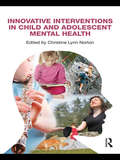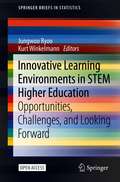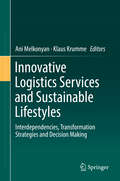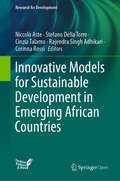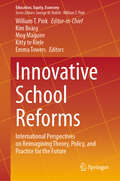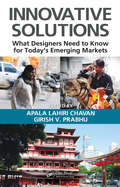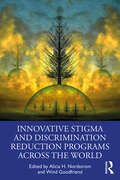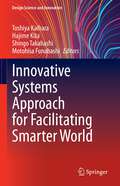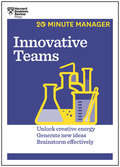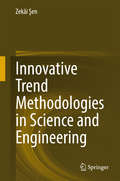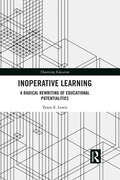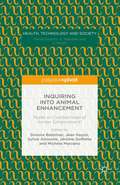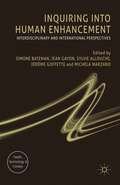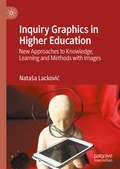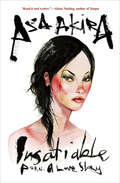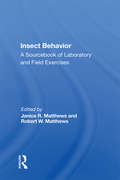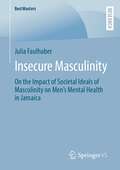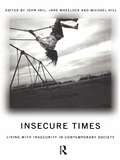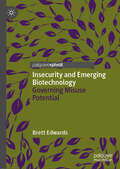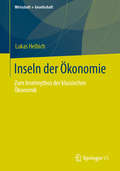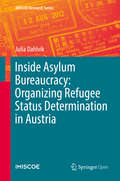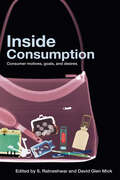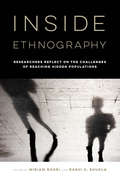- Table View
- List View
Innovative Interventions in Child and Adolescent Mental Health
by Christine Lynn NortonInnovative Interventions in Child and Adolescent Mental Health is a unique composite of the literature on various innovative interventions for children and adolescents, and provides a developmental and neurobiological rationale for utilizing innovative interventions with this population. Based on the latest research, this book emphasizes that children and adolescents need more than just talk therapy. These innovative interventions can be applied in a variety of practice settings including schools, juvenile justice, community-based counseling centers, and residential treatment. This book bridges the gap between theory and practice, and provides a historical, theoretical, and research-based rationale, as well as a helpful case study, for each type of intervention being discussed.
Innovative Learning Environments in STEM Higher Education: Opportunities, Challenges, and Looking Forward (SpringerBriefs in Statistics)
by Kurt Winkelmann Jungwoo RyooAs explored in this open access book, higher education in STEM fields is influenced by many factors, including education research, government and school policies, financial considerations, technology limitations, and acceptance of innovations by faculty and students. In 2018, Drs. Ryoo and Winkelmann explored the opportunities, challenges, and future research initiatives of innovative learning environments (ILEs) in higher education STEM disciplines in their pioneering project: eXploring the Future of Innovative Learning Environments (X-FILEs). Workshop participants evaluated four main ILE categories: personalized and adaptive learning, multimodal learning formats, cross/extended reality (XR), and artificial intelligence (AI) and machine learning (ML). This open access book gathers the perspectives expressed during the X-FILEs workshop and its follow-up activities. It is designed to help inform education policy makers, researchers, developers, and practitioners about the adoption and implementation of ILEs in higher education.
Innovative Logistics Services and Sustainable Lifestyles: Interdependencies, Transformation Strategies and Decision Making
by Ani Melkonyan Klaus KrummeThis edited volume aims to describe the transformation of supply chain management (SCM) and logistics services by merging sustainable logistics, SCM, sustainable consumption and lifestyle research. This assessment of the transformation potential serves the development of sustainable business models and optimized decision-making systems for achieving sustainable economic value creation within a green economy. In 5 sections, the volume takes a unique transdisciplinary approach to assess sustainable business practices within SCM and the logistics sector, and to understand the interactions between logistics services and consumer lifestyles while creating transparency within the decision making process. This book will be of particular interest to academics, policymakers, planners, and politicians. Section 1 introduces readers to the importance of blended research and innovation between sustainable SCM and consumer lifestyles for transformation towards a green economy. Section 2 addresses the question of how trends and developments in consumption behavior and lifestyles influence the development of sustainable logistics. Section 3 discusses the transformation potential towards sustainable logistics using the food sector as an example. Section 4 focuses on strategic decision making in SCM, and how long-term improvements of sustainability performance can be achieved. Section 5 concludes with policy recommendations as well as research and innovation perspectives for future sustainable development with SCM and logistics.
Innovative Models for Sustainable Development in Emerging African Countries (Research for Development)
by Corinna Rossi Cinzia Talamo Stefano Della Torre Niccolò Aste Rajendra Singh AdhikariThis open access book explores key issues and presents recent case studies in areas of importance for the transition to a circular model of development in emerging African countries that will minimize resource consumption and waste production. The topics covered include the development of sustainable housing models, energy and environmental issues in building design and technical systems, recycling for a sustainable future, models for humanitarian emergencies, and low-cost and web-based digital tools with applications in architecture and archaeology. The aim is to contribute to a necessary paradigm shift with respect to urban planning and usage of territories, moving from a linear urban metabolism based on the “take, make, dispose” approach to a circular metabolism. Such a change requires a focus on the relationship between the architectural, urban, and physical aspects of new developments, climate, and energy demand, as well as the identification and integration of strategies and infrastructures to achieve a high level of efficiency and self-sufficiency. The book will appeal to all with an interest in sustainable development in the African context.
Innovative School Reforms: International Perspectives on Reimagining Theory, Policy, and Practice for the Future (Education, Equity, Economy #11)
by William T. PinkThis book is a curated collection of international chapters focused on the reform of K-12 schools. Three key, yet different cultural, economic, and political settings are highlighted: Australia, the UK, and the US. Within their own context, each author details the required reforms that would maximize learning for all students. The intersectionalities of factors such a race, gender, class, ethnicity, disability, language, and economic inequities, are interrogated for their impact on the efficacy of reform strategies. Authors explore both a range of dysfunctional factors which have historically limited the efficacy of school reform initiatives, and detail a variety of forward-looking and cutting edge alternative reforms. Thus, this text can serve to stimulate a much need dialogue about the reconceptualization of schools in the future. Moreover, the cross-cultural analysis can focus this dialogue on both the similarities and differences in varying cultural settings.
Innovative Solutions: What Designers Need to Know for Today's Emerging Markets
by Apala Lahiri Chavan Girish V. PrabhuExpanding into emerging markets brings with it a specific set of challenges for designing products and services. Not only do cultural differences play a role in what, how, and why customers behave the way they do, but existing technologies, distribution channels, and the wants and needs of consumers become additional challenges when establishing ma
Innovative Stigma and Discrimination Reduction Programs Across the World
by Alicia H. NordstromOffering practical stigma and discrimination reduction programs in a range of domains including mental health, disability, ethnicity, and sexuality, this book is the answer to "What can we do?" to improve interpersonal relationships by reducing societal stigma towards social groups that are prime targets of prejudice. In this volume, researchers from four continents share empirically-supported stigma reduction programs that capitalize on creativity and psychological science. The programs capture a range of populations including high school and college students, healthcare providers, war survivors, sexual assault survivors, business professionals, and community members. With a focus on controversial topics in society today including racism, sexism, ageism, ableism, and classism as well as stigma of mental health and body image, innovative and unexpected methods of interventions are brought to life in the collected chapters from world-leading experts. The applications of theater, game playing, text messaging, and social media, as well as new formulations of educational workshops and communication strategies, shed new perspectives on how all of us can use accessible tools to make positive and productive changes on societal attitudes. This is an essential reading for professionals, academics, and students of psychology, business, HR, mental health, counseling, and social work, especially those interested in stigma reduction.
Innovative Systems Approach for Facilitating Smarter World (Design Science and Innovation)
by Hajime Kita Shingo Takahashi Toshiya Kaihara Motohisa FunabashiThis book introduces state-of-the-art concepts and methodologies on innovative systems approach that enables the grand design and implementation about Smarter World. This book also describes the shared view that the various heterogeneous social systems that make up Smarter World should be viewed as systems at an abstract level, and develop new developments in SoS and spiral systems through the cycle of analysis, synthesis and abduction. Several new concepts that integrate data-driven mechanism into traditional model-driven methodologies in systems approach are explained with practical applications. As such, it offers a valuable resource for systems engineers, system integrators, and researchers in related engineering fields, as well as government policymakers.
Innovative Teams (HBR 20-Minute Manager Series)
by Harvard Business ReviewDon't leave creativity up to the "creatives" in your organization. Fostering creativity within your team can help your organization solve problems, create innovative products, break out into a new market, and even communicate and collaborate more effectively. Innovative Teams shows you how to: Create the right environment for inventive thinking Build a diverse team Generate a wide array of new ideas Manage disagreements Make sure your ideas actually get implementedAbout HBR's 20-Minute Manager Series:Don't have much time? Get up to speed fast on the most essential business skills with HBR's 20-Minute Manager series. Whether you need a crash course or a brief refresher, each book in the series is a concise, practical primer that will help you brush up on a key management topic.Advice you can quickly read and apply, for ambitious professionals and aspiring executives-from the most trusted source in business. Also available as an ebook.
Innovative Trend Methodologies in Science and Engineering
by Zekâi ŞenThis book covers all types of literature on existing trend analysis approaches, but more than 60% of the methodologies are developed here and some of them are reflected to scientific literature and others are also innovative versions, modifications or improvements. The suggested methodologies help to design, develop, manage and deliver scientific applications and training to meet the needs of interested staff in companies, industries and universities including students.Technical content and expertise are also provided from different theoretical and especially active roles in the design, development and delivery of science in particular and economics and business in general. It is also ensured that, wherever possible and technically appropriate, priority is given to the inclusion and integration of real life data, examples and processes within the book content.The time seems right, because available books just focus on special sectors (fashion, social, business). This book reviews all the available trend approaches in the present literature on rational and logical bases.
Inoperative Learning: A Radical Rewriting of Educational Potentialities (Theorizing Education)
by Tyson E. LewisInoperative Learning embodies a weak philosophy of education. It does not offer a set of solutions or guidelines for improving educational outcomes, but rather renders taken-for-granted assumptions about the theory-practice coupling inoperative. By arguing that such logic reduces education to instrumental ends, this book presents a challenge to contemporary notions of education as outcomesbased, goal-directed learning. From the perspective of learning, the neutralization of progress, growth, and maturity would usually be seen as obstacles needing to be overcome on the path toward set goals. Yet Lewis argues that a serious investigation of inoperativity opens up possibilities that would be otherwise unavailable in a world fixated on the question of learning. In dialogue with philosophers (Agamben, Benjamin, and Esposito), authors (Kafka and Walser) and qualitative researchers (Lather), Lewis turns our collective attention to what remains when concepts such as learning, child development, teacher effectivity, and personal growth are left idle. Inoperative Learning presents a radical rewriting of educational possibilities. It should therefore be of great interest to educational researchers and educational philosophers concerned with the question of alternative logics of education beyond learning. The book may also be of interest to theorists in the critical humanities that are engaged in education as a thematic concern in their research and classroom practices.
Inquiring into Animal Enhancement: Model or Countermodel of Human Enhancement? (Health, Technology and Society)
by Jean Gayon Simone Bateman Sylvie Allouche Jérôme Goffette Michela MarzanoThis book explores issues raised by past and present practices of animal enhancement in terms of their means and their goals, clarifies conceptual issues and identifies lessons that can be learned about enhancement practices, as they concern both animals and humans.
Inquiring into Human Enhancement: Interdisciplinary and International Perspectives (Health, Technology and Society)
by Jean Gayon Sylvie Allouche Jérôme Goffette Michela MarzanoHuman enhancement has become a major concern in debates about the future of contemporary societies. This interdisciplinary book is devoted to clarifying the underlying ambiguities of these debates, and to proposing novel ways of exploring what human enhancement means and understanding what practices, goals and justifications it entails.
Inquiry Graphics in Higher Education: New Approaches to Knowledge, Learning and Methods with Images
by Nataša LackovićThis book introduces the concept of Inquiry Graphics, which positions graphics as significant and integrated tools of inquiry in higher education teaching and research. Simply put, the book explores the nuances of thinking and learning with digital images as types of graphics. Although the amount of images in modern life is overwhelming, they have been scarcely explored and understood as integral to concept and knowledge development within higher education practice. This book reflects on why and how digital photographs can be adapted and used in teaching and research contexts. It provides practical examples and applications, as well as theoretical foundations, building on a range of perspectives, such as Peircean triadic sign and approaches to conceptual development. Ultimately, it builds on diverse approaches to make a case for exploring knowledge and analysing concepts and images in a non-dualist and pluralist manner. This unique book will appeal to scholars and students in education studies and educational research, media and communication, and anyone interested in applied semiotics, visual and multimodal pedagogy and learning.
Insanity and Sanctity in Byzantium
by Youval RotmanIn the Roman and Byzantine Near East, the holy fool emerged in Christianity as a way of describing individuals whose apparent madness allowed them to achieve a higher level of spirituality. Youval Rotman examines how the figure of the mad saint or mystic was used as a means of individual and collective transformation prior to the rise is Islam.
Insatiable: Porn–A Love Story
by Asa AkiraA “hot, hilarious, and engrossing” porn star memoir. “Akira is the Galileo of women’s sexuality” (Alissa Nutting, author of Unclean Jobs for Women and Girls). After earning a good living by stripping and working as a dominatrix at a sex dungeon, Asa Akira built up a reputation for being one of the most popular, hardworking, and extreme actors in the porn business, winning dozens of awards for her 330+ movies, including her #1 bestselling series “Asa Akira Is Insatiable.” In Insatiable, Akira recounts her extraordinary life in chapters that are hilarious, shocking, and touching. In a wry, conversational tone, she talks about her experiences shoplifting and doing drugs while in school, her relationship with other porn stars (she is married to one) and with the industry at large, and her beliefs about women and sexuality. Insatiable is filled with Akira’s unusual and often highly amusing anecdotes, including her visit to a New Hampshire sex shop run by a mother and son. One of very few articulate voices writing from the inside, Akira has something important, controversial, and astonishingly interesting to say about sex and its central role in our lives and culture. “Akira is not only passionate about the porn industry, she is shameless, funny and even endearing.” —Susannah Cahalan, New York Post, Best Books of the Year “Each chapter is filled with brutal honesty and self-deprecating humor. It’s touching, inspiring, and flies in the face of a lot of people’s preconceptions about the life of an adult film star.” —Vice “Her book is a lot like her porn: raw, brutal and always unflinching.” —Salon.com
Insect Behavior: A Sourcebook Of Laboratory And Field Exercises
by Janice R. MatthewsInterest in insect behavior is growing rapidly, as reflected both in courses devoted fully to the topic and in its inclusion in general biology, ecology, invertebrate zoology, and animal behavior--as well as general entomology--curricula. Instructors and students find that insects are in many ways uniquely suitable animals for behavioral study: the
Insecure Masculinity: On the Impact of Societal Ideals of Masculinity on Men's Mental Health in Jamaica (BestMasters)
by Julia FaulhaberThis work focuses on the relationship between childhood socialization, masculinities, and young men’s coming of age in contemporary Jamaica. The author elucidates social, cultural, and historical dimensions of young men’s lifeworlds and theorizes on the potential trajectories of being emotionally well and/or un-well vis-à-vis gendered normative orders of growing up and relating to others within and beyond kinship and courtship relations. Based on fieldwork, this book elaborates on the extent to which social discourses of masculinity and men’s personal experiences of their own and other men’s mental health are reproduced in Jamaica. Faulhaber places her work in contemporary psychological and medical anthropology and aims to overcome the separation of psyche, body, and environment that is often common in psychotherapy, psychiatry, and health sciences. The author embarks on this important endeavour through critical and self-reflexive ethnography and the analysis of hegemonic narratives and discourses in media and popular culture. In juxtaposition and extension to other global mental health initiatives, this work highlights that well-being, affliction and suffering can barely be grasped scientifically as objectively measurable mental states of the individual.
Insecure Times: Living with Insecurity in Modern Society
by Michael Hill John Vail Jane WheelockAt a time when families break up and employment is often short-term, society is increasingly forced to operate against a background of insecurity. Insecure Times looks at how this sense of risk and instability has affected the major institutions of social life. With examples and research taken from a range of European and North American societies today, this innovative text on contemporary society discusses such major issues as: * the causes of social and economic insecurity * insecurity and modern capitalism * the role of the state * insecurity and housing * contemporary family life.
Insecurities in European Football and Supporter Cultures (Routledge Research in Sport, Culture and Society)
by Jan Andre LudvigsenAgainst the backdrop of the recent and renewed political and policy interest in the safety and security in European football contexts, this book examines the ways in which the regulation of insecurities in European football has been advanced by European institutions and organizations, and contested by football supporters, from the 1980s to the present day. This book therefore produces an updated empirical but theoretically informed account of how insecurities in football have been responded to and countered on a European level through expressions of power and counter-power.By drawing on material from interviews, and analyses of international legal texts, policy documents and historical football fanzines, Insecurities in European Football and Supporter Cultures uses European football as a window to understand wider processes of (in)security and the regulation of cultures, social groups and contested spaces. Utilizing perspectives from contemporary sociology and critical security studies, this book produces the argument that, as institutions’ risk-focused logics and precautionary principles have been embedded in the attempts to secure European football, it is simultaneously possible to observe a reflexive culture of contestation that has matured across four decades in European football.Insecurities in European Football and Supporter Cultures is an important, fascinating and timely reading for anybody with an interest in the sociology of sport, football, security studies, surveillance, social theory and sport studies.
Insecurity and Emerging Biotechnology: Governing Misuse Potential
by Brett EdwardsThis book examines how emergent trends in innovation and its governance are raising new and old questions about how to control technology. It develops a new framework for understanding how emergent fields of science and technology emerge as security concerns; and the key challenges these fields pose from a global security perspective. The study focuses on the politics which have surrounded the emergent field of Synthetic Biology, a field which has become emblematic of both the potentials and limits of more preemptive approaches to governance. This highly accessible work will be of interest to both scholars and practitioners working on the ethical responsibilities of innovators and the assessment of emergent technology as well as the global governance of weapons.
Inseln der Ökonomie: Zum Inselmythos der klassischen Ökonomik (Wirtschaft + Gesellschaft)
by Lukas HelbichDer Band bietet eine kritische kulturhistorische Perspektive auf die Entstehung der ökonomischen Theorie. Es wird gezeigt, dass Vorstellungen und Darstellungen von kleinen, natürlichen, abgelegenen Inseln die Wirtschaftswissenschaften von Anbeginn geprägt haben. Die analysierten Inselvorstellungen werden als kulturell konstruierter Mythos im Sinne Roland Barthes’ behandelt. Diese Vorstellungen hatten und haben bedeutende Konsequenzen für Denken und Handeln in Ökonomie und Politik. Das Buch demonstriert dies exemplarisch anhand des Romans Robinson Crusoe und dessen Rezeption durch Rousseau sowie anhand der klassischen Wirtschaftstheorien von Joseph Townsend, Thomas Robert Malthus und Johann Heinrich von Thünen.
Inside Asylum Bureaucracy: Organizing Refugee Status Determination in Austria (IMISCOE Research Series)
by Julia DahlvikThis open access monograph provides sociological insight into governmental action on the administration of asylum in the European context. It offers an in-depth understanding of how decision-making officials encounter and respond to structural contradictions in the asylum procedure produced by diverging legal, political, and administrative objectives.The study focuses on structural aspects on the one hand, such as legal and organisational elements, and aspects of agency on the other hand, examining the social practices and processes going on at the frontside and the backside of the administrative asylum system.Coverage is based on a case study using ethnographic methods, including qualitative interviews, participant observation, as well as artefact analysis. This case study is positioned within a broader context and allows for comparison within and beyond the European system, building a bridge to the international scientific community.In addition, the author links the empirical findings to sociological theory. She explains the identified patterns of social practice in asylum administration along the theories of social practices, social construction and structuration. This helps to contribute to the often missing theoretical development in this particular field of research.Overall, this book provides a sociological contribution to a key issue in today's debate on immigration in Europe and beyond. It will appeal to researchers, policy makers, administrators, and practitioners as well as students and readers interested in immigration and asylum.
Inside Consumption: Consumer Motives, Goals, and Desires
by David Glen Mick S. RatneshwarFollowing on from The Why of Consumption, this book examines motivational factors in diverse consumption behaviours. In a world where consumption has become the defining phenomenon of human life and society, it addresses the effects of critical life events on consumption motives, and the sociological and intergenerational influences on consumer motives and preferences. Its cross-disciplinary approach brings together some of the leading scholars from diverse subject areas to examine the central question about consumption: ‘why?’. This is a unique and invaluable contribution to the area, and an essential asset for all those involved in researching, teaching or studying consumption and consumer behaviour.
Inside Ethnography: Researchers Reflect on the Challenges of Reaching Hidden Populations
by Miriam Boeri Rashi K. ShuklaWhile some books present “ideal” ethnographic field methods, Inside Ethnography shares the realities of fieldwork in action. With a focus on strategies employed with populations at society’s margins, twenty-one contemporary ethnographers examine their cutting-edge work with honesty and introspection, drawing readers into the field to reveal the challenges they have faced. Representing disciplinary approaches from criminology, sociology, anthropology, public health, business, and social work, and designed explicitly for courses on ethnographic and qualitative methods, crime, deviance, drugs, and urban sociology, the authors portray an evolving methodology that adapts to the conditions of the field while tackling emerging controversies with perceptive sensitivity. Their judicious advice on how to avoid pitfalls and remedy missteps provides unusual insights for practitioners, academics, and undergraduate and graduate students.
